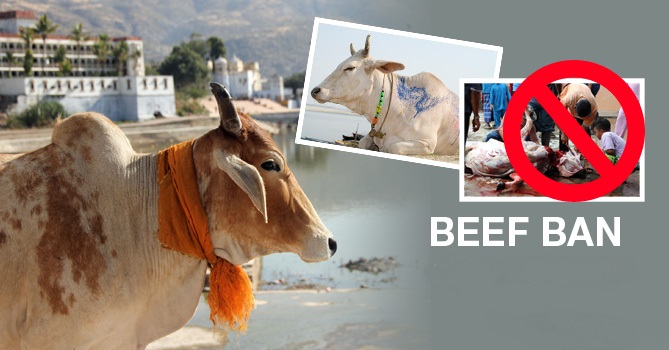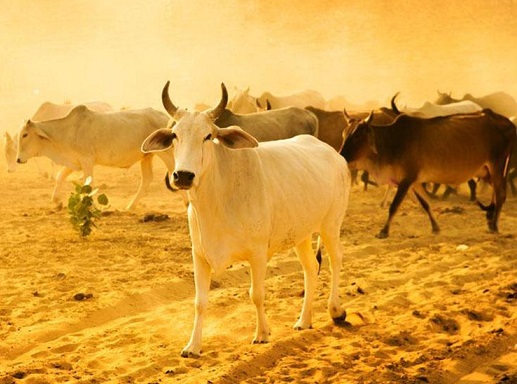
When the Maharashtra state government announced a ban on beef, many people reacted. While Hindu groups welcomed the ban on religious grounds, the meat lobby protested against it citing economic reasons. The protesters felt the government is introducing the ban just to satisfy a small minority of religious fanatics, without understanding the concerns of the vast majority of people who depend on cow slaughter for their daily livelihood. As followers of Lord Krishna and the Bhagavad-gita, we understand that the protesters are putting forward groundless accusations against the government and the ban. They are ignorant of the great benefits one can derive simply by loving and protecting cows.
Let us debunk some popular myths surrounding cow protection:
Myth 1: Cow-slaughter is an ancient Vedic practice
It is commonplace in all parts of the industrialized world and is also becoming more and more common in India to see many prosperous meat-based fast-food chains. Many Indians wrongly think that cow slaughter has always been a basic feature of civilizations outside India. But that is not the case. The ancient Egyptians prohibited cow slaughter. The Hebrews, among others, restricted it to religious sacrifices. Still today, the pastoral peoples of East Africa slaughter cattle only during rituals and ceremonies. The communist dictator of modern China observed, “Draft oxen are a treasure to the peasants. They must never be killed.” One might ask how an avowed atheistic leader such as Mao Zedong could have allowed himself to support a religious belief against killing oxen.
Anthropologist Marvin Harris suggests that religious and ritual restrictions on cow slaughter and eating of cow flesh were not irrational laws but important tools for the welfare of society. The draft power or milk of the animal was too valuable to lose. And wasting pasture to feed many cows for slaughter would eventually have brought starvation.
Myth 2: Banning beef has more to do with beliefs than agriculture.
Historically speaking, it was in the Middle Ages in Europe that the draft horse began to push the ox out of agriculture. Even though horses needed costly grain, they could plow much faster than oxen.
“They were able to increase greatly the amount of food that one farmer could raise, which meant that more men were freed to pursue the arts and crafts,” observed agricultural historians Vernon Carter and Tom Dale. So people started shifting to the towns, and oxen started heading for slaughter.
Myth 3: Cows were always slaughtered in giant mechanized slaughterhouses.
In the 1700’s, the industrial revolution speeded up cow slaughter. New farming machines and new crops such as clover and turnips made cows easier to raise for meat. And technological advances increased the output and efficiency of slaughterhouses. So producers could supply meat more cheaply. Factory life forced people to change what they ate. Unlike the farmer, the factory worker couldn’t go home to a lunch of lentil stew or porridge. Bread and meat were more convenient. So the factory worker’s food preference changed to meat, and because his income was increasing, he could afford it.
In the Industrial Revolution, Frederick Dietz writes, “Since meat was coming to be more valuable than powers of draft in an ox, traditional breeds that provided milk and draft power tended to be replaced by such new breeds of cattle as the Durham shorthorns, the Herefords, and the Devons.” So the industrial revolution bred beef cattle. But it was across the ocean in the newly developing American nation that raising cows for meat would become a big way to gain wealth. This is somewhat ironic because in America until about 1840, when draft horses became more widespread, oxen were the main source of agricultural traction. A team of oxen could be bought for one sixth the price of a team of horses, oxen could do the same work for less expense in feed, and oxen were resistant to disease. Ben Franklin noted, “The farmers are more thriving in those parts of the country where cattle are used than in those where the labor is done by horses. The latter are said to require twice the quantity of food to maintain them.”

Modern civilization is centered on animal killing. History, in fact, shows a grim picture: the sacred cow killed for the sacred dollar.
Myth 4: The Green Revolution actually gave high-yield harvests.
In Food Crops Vs. Feed Crops, David Barkin, Rosemary Batt, and Billie DeWalt tell how, in country after country, feed crops for meat production edged out food crops as the Green Revolution advanced. In Mexico, for example, land traditionally used for corn and beans for people gave way to wheat and sorghum for animals. Productivity and profits went up. More people went hungry. As food aid had pushed small farmers off their land by driving down crop prices, the Green Revolution pushed them off by driving up prices for land and rent. Farm land in the third world kept converging into the hands of a few. As wealthier farmers profited from credit and technological advances, they brought bigger harvests to market. This raised land values. So nearby subsistence farmers, unable to make enough to pay rent and taxes, got pushed off their land to join the hungry. The Green Revolution featured new seeds called “high-yield.” They were not inherently high yielding, but they yielded more in response to technological inputs like chemical fertilizers, pesticides, and so on.
The ecological toll of the Green Revolution was devastating. Vandana Shiva, physicist and agricultural philosopher, tells of it in The Violence of the Green Revolution. Switching from thousands of types of local grains to a handful of new hybrids dangerously shrank the genetic pool of local seed types. Switching from cow manure and green manure to chemical fertilizers degraded the soil, making it poor in micronutrients and toxic. The irrigation needed for the new hybrids made some land soggy and salty and turned other land into desert.
All over the world, agriculture was suffering similar problems. Slaughtering the ox to replace him with a tractor, and replacing food grains with feed grains for meat, had failed to bring peace, abundance, and prosperity. Instead, as Srila Prabhupada said, it had polluted the world with conflict, pestilence, and famine.
What about cow-slaughter in the Vedas?
In the Rig Veda (9.46.4) the words gobhir prinita matsaram indicate that one who, being fully satisfied by milk, is desirous of killing the cow is in the grossest ignorance. Another prayer states: “My Lord, You are the well-wisher of the cows, wise men and the entire human society and world.” (Visnu Purana 1.19.65) The purport is that special mention is given in that prayer for the protection of the cows and the brahmanas. Brahmanas (not by birth but by qualification) are the symbol of spiritual education, and cows are the symbol of the most valuable food. These two classes must be given all protection – that is a sign of real advancement of civilization. In modern human society, spiritual knowledge is neglected, and cow killing is encouraged. It is to be understood, then, that human society is advancing in the wrong direction and is clearing the path to ruination.
Sacrifice as mentioned in the Vedas is not actually cow-killing. In such a sacrifice an old bull or cow was sacrificed for the sake of receiving a fresh younger life by the power of Vedic mantras. But in this age of Kali-yuga, such cow sacrifices are forbidden because there are no qualified brahmanas capable of conducting such a sacrifice. In fact, in Kali-yuga all yajnas (sacrifices) are forbidden because they are useless attempts by foolish men. In this age, only the sankirtana-yajna is recommended for all practical purposes.
In the Vedic scriptures there are concessions for meat-eaters. It is said that if one wants to eat meat, he should kill a goat before the goddess Kali and then eat its meat. Meat-eaters are not allowed to purchase meat or flesh from a market or slaughterhouse. There are no sanctions for maintaining regular slaughterhouses to satisfy the tongues of meat-eaters. As far as cow-killing is concerned, it is completely forbidden. Since the cow is considered a mother, how could the Vedas allow cowkilling? The Bhagavad-gita (18.44) clearly says that cows should be protected. krsi-go-raksya-vanijyam vaisya-karma svabhava-jam: “The duty of vaisyas (mercantile class) is to produce agricultural products, trade and give protection to cows.” Therefore it is a false statement that the Vedic scriptures contain injunctions permitting cow-killing. When there is no other food, someone may eat meat in order to keep from starving. But it is most sinful to regularly maintain slaughterhouses just to satisfy our tongue. Actually, human society cannot be called human until this cruel practice of maintaining slaughterhouses is stopped. And although animal killing may sometimes be necessary for survival, at least the mother animal, the cow, should not be killed. That is simply human decency.
Conclusion
So when we hear so-called nutritionists condemn milk as a mucus-forming menace to health, and when we hear others claim that their “science” shows us it’s perfectly alright to slaughter the cow and eat her flesh, we can only feel pity that such people haven’t heard enough of Lord Krishna ’s philosophy to know better. Unfortunately, in our “advanced” civilization, people neglect spiritual knowledge and promote cow-killing on a massive scale. “It is to be understood, then,” writes Srila Prabhupada, “that human society is advancing in the wrong direction and is clearing the path to its own condemnation.”
Syamananda Dasa is the chief editor of BTG India.
